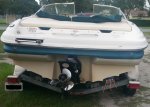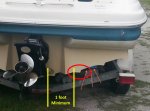Before you start putting screw holes in your boat, try setting right on the hull near the motor or really anywhere you can get access to that is in the water all of the time. If the hull isn't cored the transducers can often read right through the hull. There is usually a flat area built up for mounting a bilge pump which is often cored and needs to be avoided. If it works you can epoxy it in place for a permanent mounting.
+1 Hands down on that boat I would mount it inside. Over the years, especially on that hull with what you are going to be doing with that boat and on that trailer inside will keep it out of "harm's way" Best place is a few inches in front of the transom as close to the centerline as is practical. Epoxy mounting is the best method as epoxy sets up rigid and you want solid material between the transducer and the water outside.
Transducers convert electrical signals to sound waves and on the return trip just the opposite. For best results, the harder the material the better, no foam, no soft glue, no air bubbles and all that which will attenuate the signal.
You have 2 choices on that hull mounting inside. If you mount it flush with the hull you will have a slight depth error caused by the angle of the dead rise at the stern, but the shallower the water the less that matters. At 50' you could have a few feet error but so what....do the math. You have the dead rise angle and the beam width. 1/2 the beam, on the lower side will mitigate the effect of the dead rise any way so still no big deal.
Your transducer will pickup anything that appears in the transmitted cone. If the cone is a nominal 20 degrees you will have a 20 degree cone that gets larger in area as you get in deeper water. A reply at a certain depth could be anywhere within that cone. For this reason, some folks, like bassers prefer the systems with the reduced tx/rx cone angle to aid in pinpointing structure.
I doubt that boat has foam or a balsa core and boats that do usually don't have it all the way to the transom. You can easily tell by tapping on the place where you want to mount it. If it sounds solid it probably is.
Finally you ask yourself: What am I going to expect with this mounting. Get on the water with a 1 gallon plastic zip lock bag and your transducer unmounted. Secure the boat so that there is minimum movement, depth where ever, 10' is a number. Place the ducer over the transom, obviously in the water, pointed down and take a reading....record it in your head or however you choose. Fill the bag with water and put the ducer in the bag with the water and set it in the boat where you plan to mount it......the water helps ensure that the ducer has a pretty good solid connection to the hull. Take another reading. Compare the two. That's what you can expect.
When you mount it if you are a purist, you can make a little framework of cardboard such that your mounting surface is level......taking out the dead rise angle of the transom and fill the whole thing with bubble less epoxy as best you can but whichever way you mount it, press the ducer into the epoxy ensuring a good covering......be best to coat the bottom of the ducer with some epoxy prior to mounting to aid in ensuring a good connection.
On temperature, on my last boat I had 2 identical systems, one transducer mounted on the bottom of the trolling motor and the other at the transom mounted inside. On water temps in the area of 80 degrees my difference usually was around 2 degrees and obviously the one at the transom was the error. But 2 out of 80 is approaching 2% and that isn't much error....can you tell when the ambient temp changes 2 degrees? I can't. My boat was alum. and yours is glass and expect the error to increase to maybe 5% due to the fact that alum conducts heat better than glass so it can track changes in water temp faster, but still no big deal.
Your return will be slightly weaker that if it were mounted outboard, but the big plus is that turbulence is HIGHLY reduced and you can operate at higher speeds and see what's going on whereas on outboard mountings, usually around 35 or so, you have so much turbulence you can't make out anything.
Now how do you suppose I know all this!
Good luck,
Mark
PS: The bag and water were just for testing purposes. Do not use either in the final mounting.
 Hi all, I bought a lowrance chirp 4 fishfinder and I'm getting ready to install the transducer. I'm a little nervous about installing in the wrong place and having to relocate and ending up with unneeded screw holes in the transom. I was hoping you could give me some feedback and let me know if this mounting location is ok. I'm planning on in between the 2 strakes just below the bottom of the boat.
Hi all, I bought a lowrance chirp 4 fishfinder and I'm getting ready to install the transducer. I'm a little nervous about installing in the wrong place and having to relocate and ending up with unneeded screw holes in the transom. I was hoping you could give me some feedback and let me know if this mounting location is ok. I'm planning on in between the 2 strakes just below the bottom of the boat. 



















